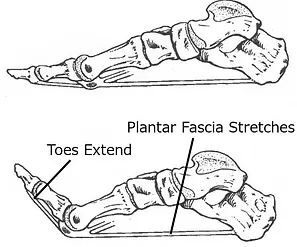Achilles Tendinopathy is one of the most common running injuries we treat in clinic. Tendinopathy refers to pain, disorganisation and degeneration of the tendon.
The achilles tendon is the biggest and strongest tendon in the body. Studies show that during running the achilles tendon takes forces anywhere between 6-8x body weight! (Giddings et al., 2000)
Achilles tendinopathy can be described as insertional (where the tendon meets the ankle bone) or mid-portion (the body of the tendon). There are 3 stages of tendinopathy;

Biomechanics can have a big influence on the achilles. Altered biomechanics can place extra load and strain onto the achilles, resulting in higher risk of injury.
This may include the use of sports strapping, strengthening of specific muscle groups or even looking into orthotics.
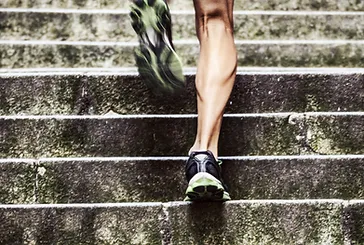
Tendons need a load to recover – but the appropriate load is key! Achilles tendinopathy results in pain and reduced capacity of the tendon. Thus, it is important to appropriately load (not too much and not too little) the tendon with specific strengthening exercises to gradually improve capacity.
Amazingly, studies have shown that appropriate loading, that are linked to functional tasks, not only helps reduce tendon pain but also modulate excitatory and inhibitory control of muscle, and thus increase tendon capacity! (Rio et al, 2015
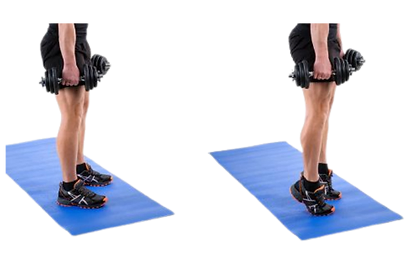
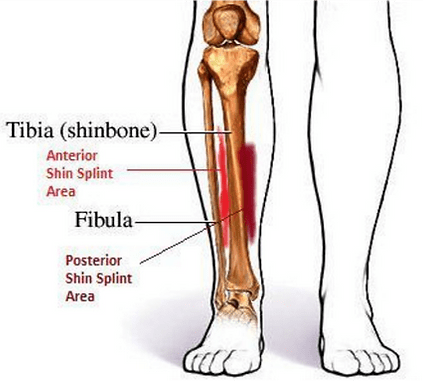
Shin splints, also known as Medial Tibial Stress Syndrome (MTSS), is exercise-induced pain along the shin bone caused by repetitive stress loading during activities like jumping or running.
MTSS is common in endurance sports, such us running, triathlon and football. Symptoms include dull pain at the lower two-thirds of the shin and tenderness of the surrounding soft tissues. The main complication if left untreated is the development of a bone stress fracture.
Runner’s Knee is an over-arching term used to describe various conditions that lead to pain around the front of the knee. Although referred to as ‘Runner’s Knee’, there are other activities which can lead to this condition, like jumping, walking or cycling. Two of the most common conditions related to Runner’s Knee that we see in clinic are Patellofemoral Pain Syndrome and Iliotibial Band Friction Syndrome.
Patellofemoral Pain Syndrome (PFPS) is used to describe pain arising from the patellafemoral joint itself. This joint is made up of the patella (kneecap) which sits within the femoral groove of the femur (bone). The surrounding soft tissue helps to keep the joint in place as well as aiding to create minimal friction as the patella slides and glides during movement. This soft tissue includes; synovial fluid, ligaments, bursa and tendons.
PFPS can be a result of acute trauma (eg. a fall) but more commonly is a result of a combination of factors. These factors include;
Overload / Overuse
Anatomical Abnormalities
Biomechanical Issues
Muscular Weakness, Imbalance or Dysfunction
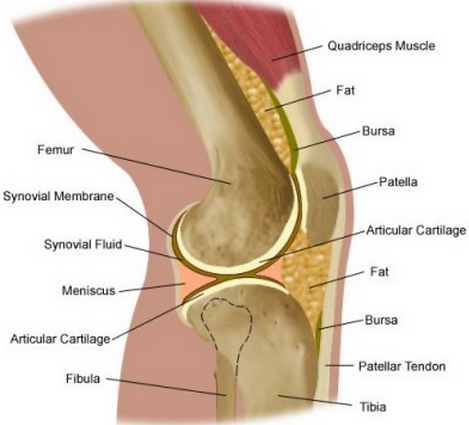
Iliotibial Band Syndrome (ITBS) is a compression-type injury in which the lower part of the iliotibial band (ITB) as it attaches to the knee. The tissue underneath the part of the ITB that attached to the knee is highly sensitive. The compression and inflammation that occurs at this site causes pain at the outside portion of the knee.
The ITB is a thick band of fascia that originates at the iliac tubercle (hip bone) and runs along the outside of the leg to attach to the outside of the tibia (shin bone). What makes the ITB so unique is that it is connective tissue and so it’s properties differ to that of muscle, tendon and ligaments.
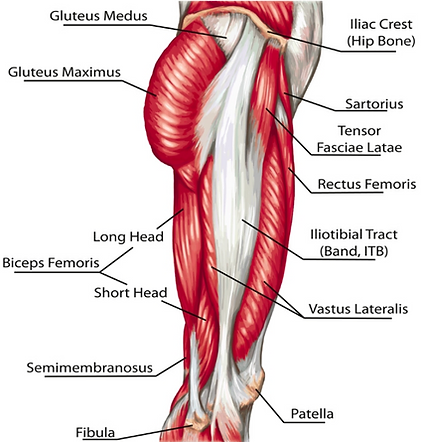
Unlike other tissues like muscles or tendons, the ITB does not contain contractile properties and therefore does not perform contractions in the body! This is a key characteristic of the ITB and important to consider when dealing with ITBS. As such, when treating ITBS, the actual underlying cause of this issue is most likely due to the muscular attachments that connect to the ITB – rather than the ITB itself!
One of the most important muscle groups in running is the hamstrings muscle group. The hamstrings are active at numerous stages in the running gait cycle, particularly in performing the actions of hip extension and knee flexion. The hamstrings muscles share a common origin on the lateral aspect of the ischial tuberosity and comprise of the Biceps Femoris, Semitendinosus and Semimembranosus muscles.
Proximal Hamstring Tendinopathy (PHT) is commonly seen in endurance and long distance athletes like runners, triathletes but also in sprinters and hurdlers. PHT is characterised by deep, localised pain in the region where the hamstrings attach to the ischial tuberosity (sit bones).
Pain tends to be worse when performing activities like running, squatting, lunging and even sitting (which compresses the tendons). PHT may involve tendon degeneration, peritendinous inflammatory reactions as well as nerve entrapment – called ‘Proximal Hamstring Tendinopathy-related Sciatic Nerve Entrapment’.
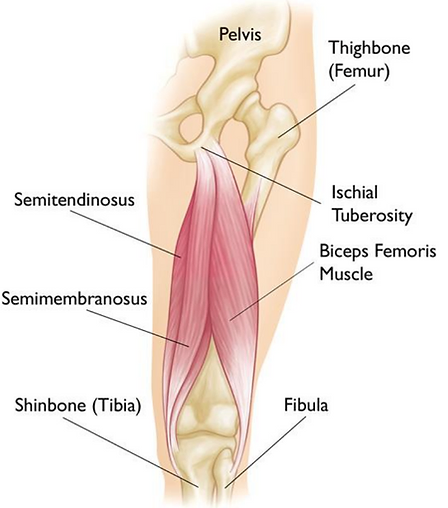
The hamstring muscle group has a big role to play as they control movement at two big joints – the hip and the knee! Research has shown that muscles that simultaneously work to regulate movement at two joints are at a greater risk of injury.
But these muscles do more than just extend the hip and flex the knee! At the phase when your lead foot is just about to hit the ground, the hamstrings act like a break to slow down your leg that has been powerfully propelled forward by your quads and hip flexors. While they are acting like a break, they are also elongated to almost their full length – which is known as eccentric muscle contraction.

MRI of a grade 1 hamstring tear
This means that the hamstrings are having to stretch to almost full length while at the same time contracting to slow down the leg, this produces enormous tensile strain in the muscle. Given all of this, it is no wonder that the hamstrings are one of the most common sites of muscle strains and tears!
Plantar Heel pain is often referred to as Plantar Fasciitis, which is thought to be an injury caused by inflammation of the plantar fascia. However, inflammation is not actually the main culprit… (Lemont et al., 2003)
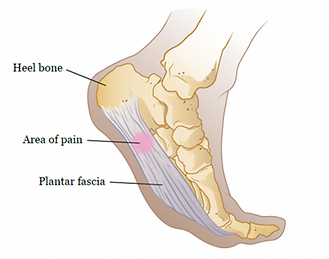
Plantar Heel pain is more accurately described as Plantar fasciosis, and is actually caused by degenerative changes to the fascia on the bottom of the foot. (Lemont et al., 2003)
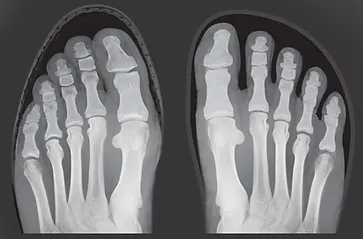
These degenerative changes and a reduction in blood flow can be caused by several factors including, Over-stretched plantar fascia, toes in the extended position and reduced toe splaying.
